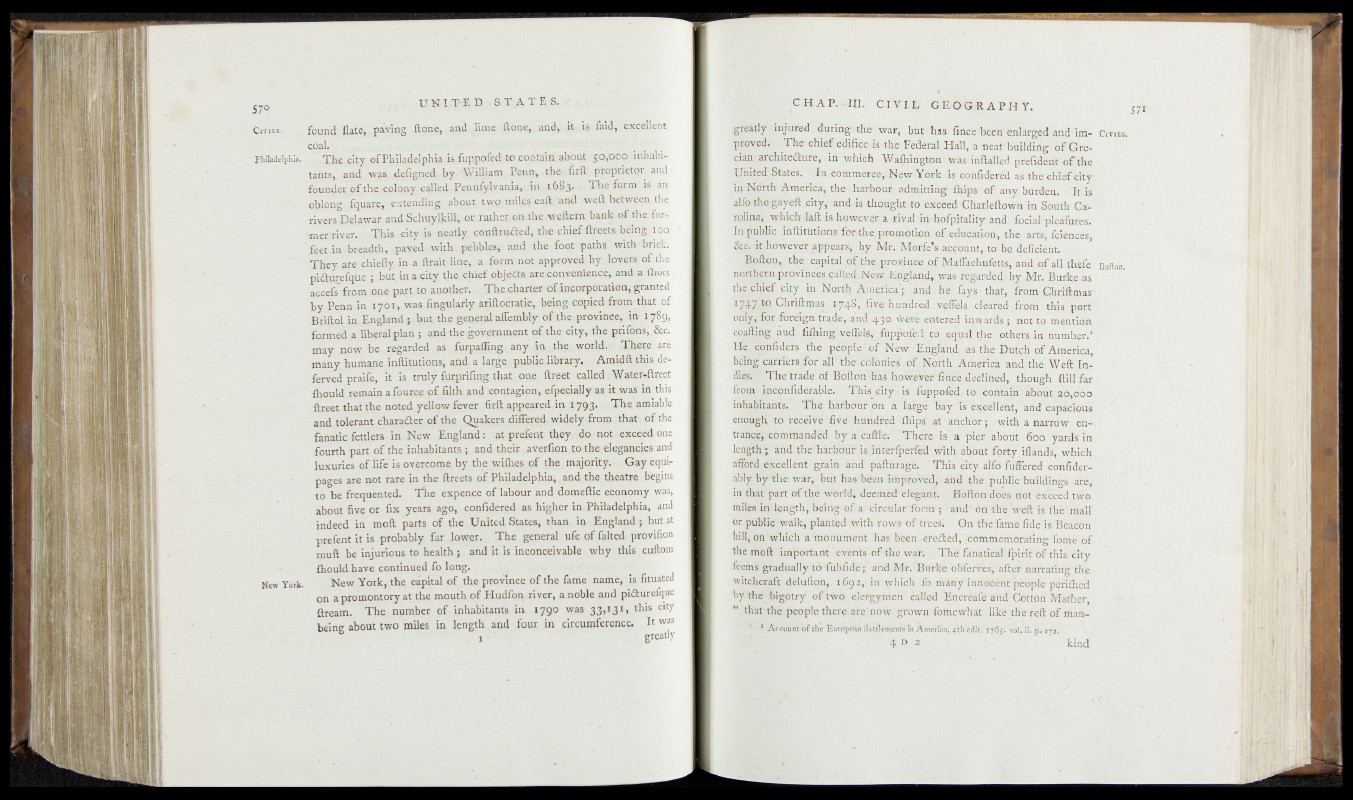
UNIT- ? TR-s.
5 7 9
C it ie s . found Gate, paving ftone, and June ftone^ and, it, i§ laid, excellent
Philadelphia., ; The city of Philadelphia is fuppofed to contain about 50,0.00; inhabitants,.
and was defigned. by William Penn, the firlt proprietor and
founder of the colony called Pennsylvania, in 1683. The form, is an
. oblong fquare, extending about two miles eafl ’'and weft between the
livers Delawar and Schuylkill, or father,on.the weftern bank of the former
river. ’ This city is neatly conftrudted, the chief- ftreets being, loo-
feet in breadth, paved with pebbles,- and the foot paths with-brick.
They are chiefly in a ftraitfine, a form! not approved byttoyefs ofethe
pi&ureftpie j, but in a city the, chief «bjefts, are convenience, .and a fttort
accefe from one part to another. The charter otiaeprpo^tion, granted
.by Penn in 1701, was Angularly ariftocpdic, being copied ffomriiiat .of?.
Briftoi in England j but the generalaffembly pf the province, in i f f 9,
formed a liberal plan ; and the government of the Qitf^t'he prifonsÄc.
may now beä regarded as furpaffing any iu.jh^yorld.* arg
many humane inftituriep^ and a large public library, Am id ft^ s de-
ferved praife, it is tralyTurprifing-that ,orte, ftreet palled Watf^ftreet
fhould remain a fource of filth and contagipn, qfpecially as it was iri this,
ftreet that the noted yellow fever firft .appeared -ia 1793,, The amiable
and tolerant chara&er of the Quakers differed widely froip, that, of: the
- fanatic fettlers in New England: at prefent they,.do ndt^exceed one
fourth part of the inhabitants ; and their ayerfiop tqthe,plegancies and
luxuries of life is overcome by the wifhes of the majority..-; Gay |gni-
pages are not rare in the ftreets of Philadelphia, and the theatre begins
to be frequented, llie expence of laWur and domeftic economy^ras,
about five or fix y ears ago, confidered as higher in-Philadelphia, and
indeed in rood parts of the. United. States, than ip. England y hut at
prefent it is probably far lower. The general ufe of, faked provifion
muft be injurious to health ; and it is .inconceivable why this cuftoro
fhould have continued fo long. ' ,
New York. New York, the. capital of the province of the fame' name, jÄqtated
on a promontory at the mouth of Hudfon river, a,noble and-ipi'dfurefque
ftream. The number of inhabitants in 1790 was 33,131, thk
beine about two miles in length and four in circumference. It was
6 x ' p ^ y
HAP . ' I l lT cT V I L GT (KG® a P H Y. 57t
greatly -injured durih^tfte war, but'hasfffnc'Tbeeiihnlargdd and im- Cities.
proved; The* chief-edtfice^s the, PederMf^lpJa^lnear buftdi^gr ofGre-
ciani,afehiteauce, ,;jn whi^|Wafhiugt^rihwasdnftahed piefide^c^fthe
UhitedfStates. b>Iale6mdieffee$;NewlYrdrk fftphMtidered as.thetchi'eftcity.
hnNdrth America, the-rharbour * idinittfrag’ fhipst'of^h^/BMKi^' It is '
al^fthe-gayeiCctty,- andisuhonght-ta'ekeeeiirCKayleftowh fttBbuth Gar-'"'
roMha-i Wh iqb JaA ;is-joi®wqva?r a rj-yal iq -hofvitality, and ‘feciaipleafufds.
rffipftHicridftitorions fo|^e^pro{n«ti^u^ftg#u^4Iti,oh, the artsy faiences ■
&c. it however appears, by Mr. Moffe’s account, to be deficient.
Bofton, the capital of the province: of Maffachufetts, and of all thefe Bottom ‘'
northern provinces called. New Ebgjandy was regarded by Mr. Burke as
the chief city in North 'America'; ‘ and he fays that, from Cbriftmas
*747 $| Ghriftmas 1748,; live hundred v.eflels cleared fro m- this '.pact - ~-
oujysr|pr ftlr^gn trade,y^d;?4^.^ere.e^^ediipwarft^vnWi^3^ n ’yif{p
c9|ftjPS aQd ami-ah the mothers. in aumbieri^f-
% T^^1eTdf“^ew’_ Ertg|an£.as ttjp Duterhloft^toerica,
befnglarrrers^or-aii the c Mb nip' of NoMhl^meFma /and! the’- Weft In-
The trade of We’ver ftn'ce’^llifed, XthJ^|SlillMr -
fr|m i^confifterable.- Thisei^risS - j.
i-nhabMrife/ The HahTour'dn a large ’bay ip%^ellehfr'an^^a<|©u^,
enough' t©!r6c|ive,; five Hundred ftdps*'at ' anchor; with a h^fr&w; en-A
trancepcomttiaud^ by a’ caffleA Thefe^is^V^igp'^about ^ o ’' yards’®!., ,
lengtbyahdfthe hkboiifaslnterfperfed .with about fbrty’iflaA'dl^Whmh
afford <|$eell&ht grain -and pafturage. ’ Thik fc^y affd fft^ered“- '^iider-^ ' ? 1
ably‘By ;tlie' war, but has been fthpfoved^ ahdf^e
in that part of the world, deemed' elegant. Bdft'On .docs not exceed two
miles in length, being-of a circular form- ; and on, the weft is the mall
or public walk, planted with-rows; of trees*! On the fame fide is Bfeacpn /
’hfi, ori which a monument has been’ erefted, .commemorating-'feme of
the mo ft important f eyerits-of five war. The fanatical fpirit'of this city .
feems gradually to -fublide; and Mr. Burke obferves, after narrating tiic, !
witchcraft delufion, 1692, in which fo nTahydnriaieht.people perifhed
hy the 'bigotry of'two clergymen« called Eticireafe and Cotton Mather,
■“ that the people there-are now grown fomewhat like the reft of IJan-
I 3 .Account of the European Set'flemento“hi.A'inetf<»/^th’edit. 1765. Yol.ii. p. 172.
■ 4 D. 2 kind